Music lovers understand that a well-decorated piano room enhances both the visual appeal and the overall experience of playing. Thoughtful décor choices not only highlight the piano as the focal point but also create a harmonious atmosphere perfect for practice, performance, and relaxation. From classic elegance to modern minimalism, styling the space around your instrument reflects personal taste while elevating the ambiance of your home. As pianos remain timeless centerpieces, incorporating décor that complements their presence adds warmth and charm. This blog shares top piano room decor ideas designed to inspire beautiful, functional spaces that celebrate the art of music.
Incorporate a Gallery Wall Above the Piano
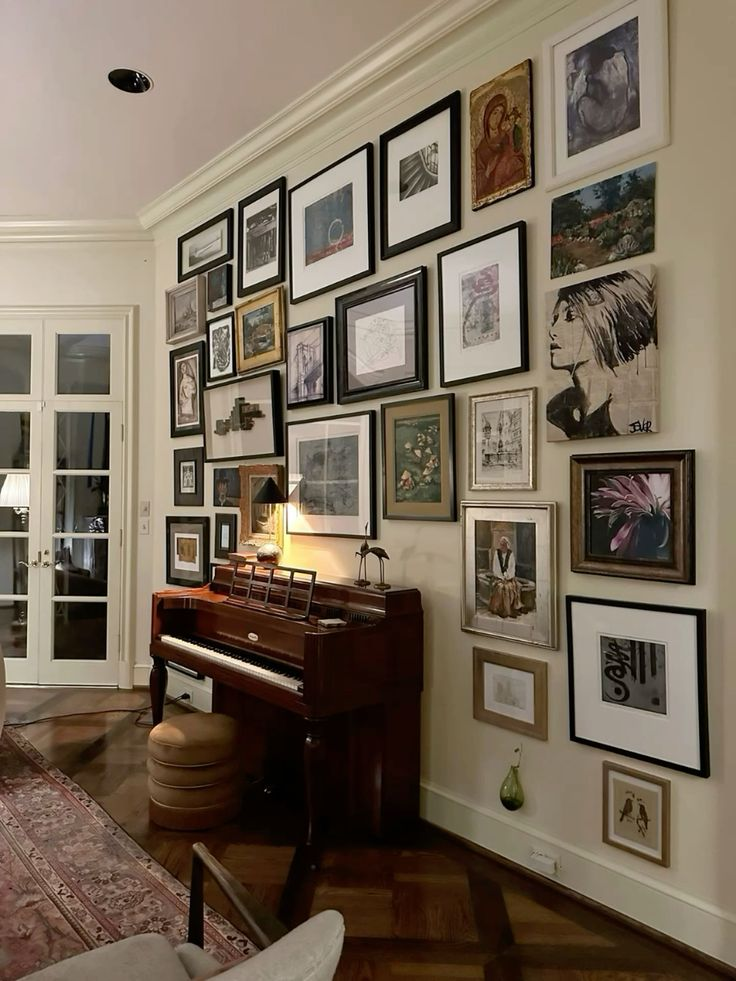
Showcasing artwork above the piano creates a refined focal point that draws attention to the instrument. A gallery wall filled with curated art pieces, family photos, or musical-themed prints adds visual interest while personalizing the space. Opt for matching frames or a mix of finishes to reflect your style, ensuring the arrangement feels cohesive. This approach enhances the room’s character while complementing the piano’s grandeur. Large statement art pieces or symmetrical clusters create balance without overwhelming the area. Keep the spacing even to avoid a cluttered look and let each piece breathe. Incorporating vintage sheet music or framed musical notes ties the theme together beautifully. Selecting art with varying textures and hues adds dimension, while picture lighting subtly highlights the collection. The gallery wall not only elevates the aesthetic appeal but also creates a harmonious backdrop, making the piano a centerpiece within a well-curated, elegant setting.
Utilize Textural Elements for Warmth
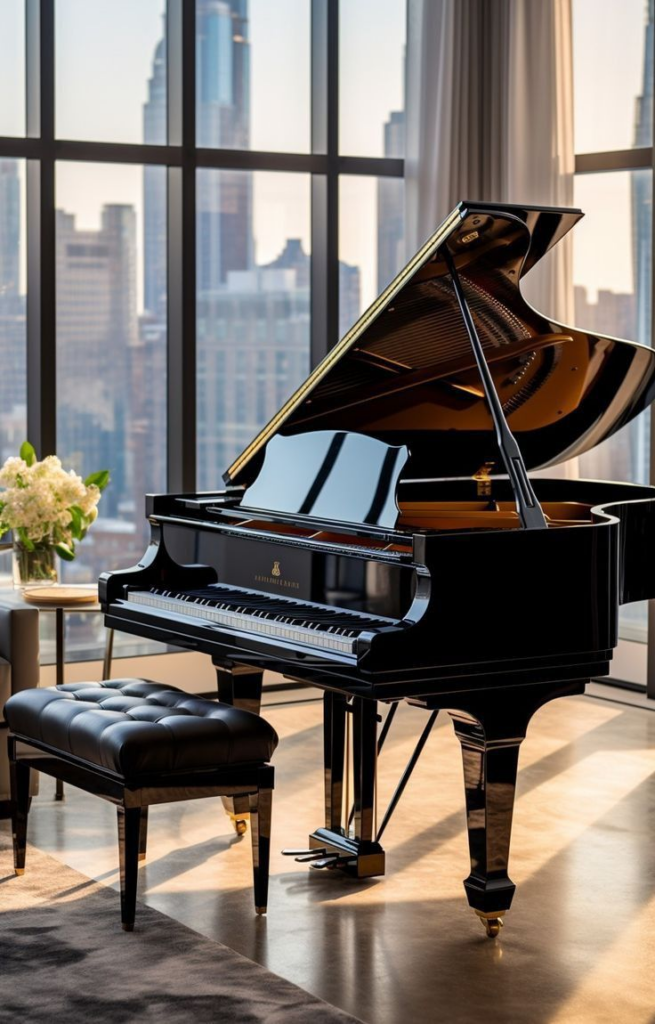
Textured elements such as plush throws, soft cushions, and tactile fabrics enrich the piano room’s ambiance. Integrating textiles with varied materials like velvet, chenille, or linen helps achieve a welcoming atmosphere while enhancing acoustic qualities. Curtains in rich fabrics not only frame windows beautifully but also improve sound absorption. Consider layering different textures, such as a jute rug beneath a velvet armchair, for added depth. Wall treatments like grasscloth wallpaper or wood paneling introduce subtle dimension while warming up the space. Even small additions—like a knitted pouf or a tufted bench—contribute to comfort and style. Choosing complementary textures ensures the space remains cohesive and inviting without distracting from the piano. Balancing hard surfaces like wood floors and the piano’s sleek finish with cozy, tactile materials results in a harmonious environment. This thoughtful integration of texture offers both functional sound management and aesthetic charm, perfect for a well-designed music sanctuary.
Implement Dark Wall Colors for Contrast

Rich, dark wall colors instantly amplify the elegance of a piano room while providing striking visual contrast. Deep hues like navy, charcoal, or forest green serve as sophisticated backdrops that allow the piano’s finish to shine. These shades create an intimate atmosphere, perfect for a space dedicated to music and creativity. Dark walls also enhance the perception of depth, making the room feel grander. Pairing darker tones with metallic or light-colored accents, such as brass sconces or ivory upholstery, prevents the space from feeling too heavy. Matte finishes work particularly well in reducing glare while maintaining a luxe appeal. Thoughtfully incorporating dark tones alongside natural light balances the mood and prevents overwhelming the space. Whether it’s a feature wall or the entire room, this color palette complements traditional and modern pianos alike. The overall effect is both dramatic and timeless, elevating the piano room into a refined, artistic retreat.
Accessorize with Mirrors and Greenery

Mirrors and greenery offer a perfect combination of visual balance and refreshing energy within a piano room. Strategically placed mirrors help reflect natural light, amplifying brightness while creating the illusion of a larger space. Antique mirrors or those with ornate frames can serve as decorative art pieces, enhancing the room’s overall sophistication. Alongside reflective surfaces, incorporating lush plants introduces vibrant color and softens the rigid lines of the piano. From tall fiddle leaf figs to trailing pothos, greenery enlivens the environment and improves air quality, offering functional benefits. Opting for stylish pots or planters ensures the plants complement the room’s décor rather than appearing as afterthoughts. Additionally, placing greenery near mirrors doubles their visual impact, creating layers of depth. This harmonious pairing of nature and reflective surfaces creates a serene yet elegant ambiance. Together, mirrors and greenery balance structure with organic beauty, offering a stylish, refreshing piano room retreat.
Incorporate Architectural Details
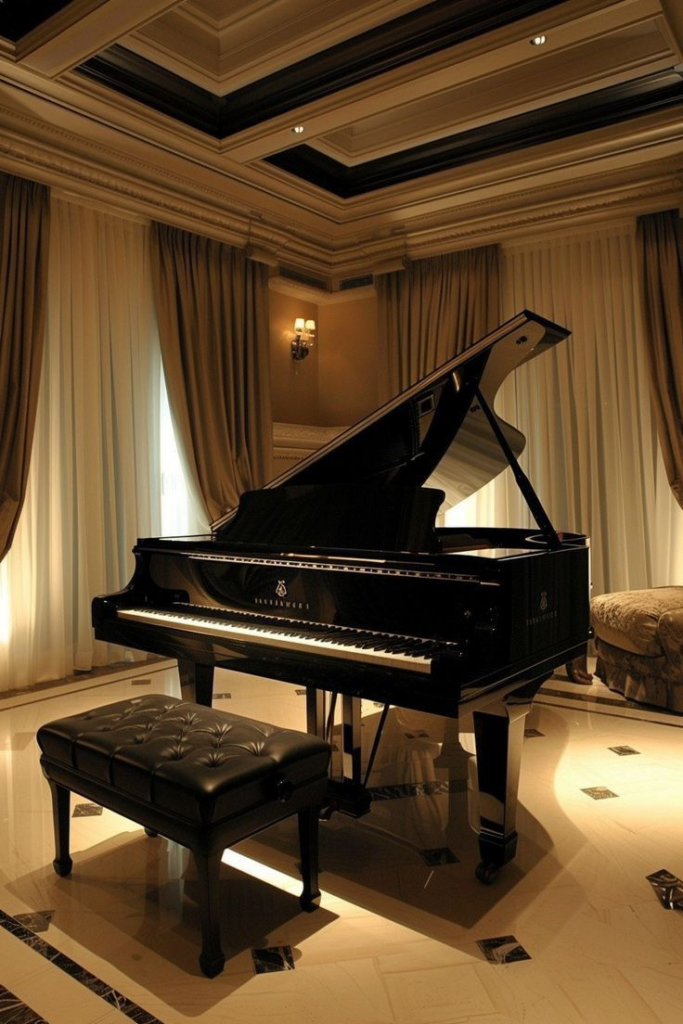
Architectural enhancements such as crown molding, wainscoting, or coffered ceilings provide timeless elegance to a piano room. These classic details add depth, texture, and visual interest without overpowering the main focal point—the piano. Installing traditional millwork frames the space beautifully, reflecting sophistication and grandeur often associated with musical settings. Wainscoting, particularly when painted in contrasting or complementary tones, creates a structured backdrop that anchors the piano effortlessly. Ceiling treatments, including beams or decorative plasterwork, draw the eye upward and lend an air of grandeur. These architectural elements also improve the room’s acoustics by adding reflective surfaces that balance sound. Materials like natural wood or intricate carvings enhance the aesthetic while maintaining harmony with the piano’s finish. Whether embracing ornate traditional designs or clean, modern lines, architectural details personalize the space while honoring the instrument’s classic appeal. This thoughtful layering transforms the piano room into a refined, inspiring environment.
Integrate a Statement Light Fixture
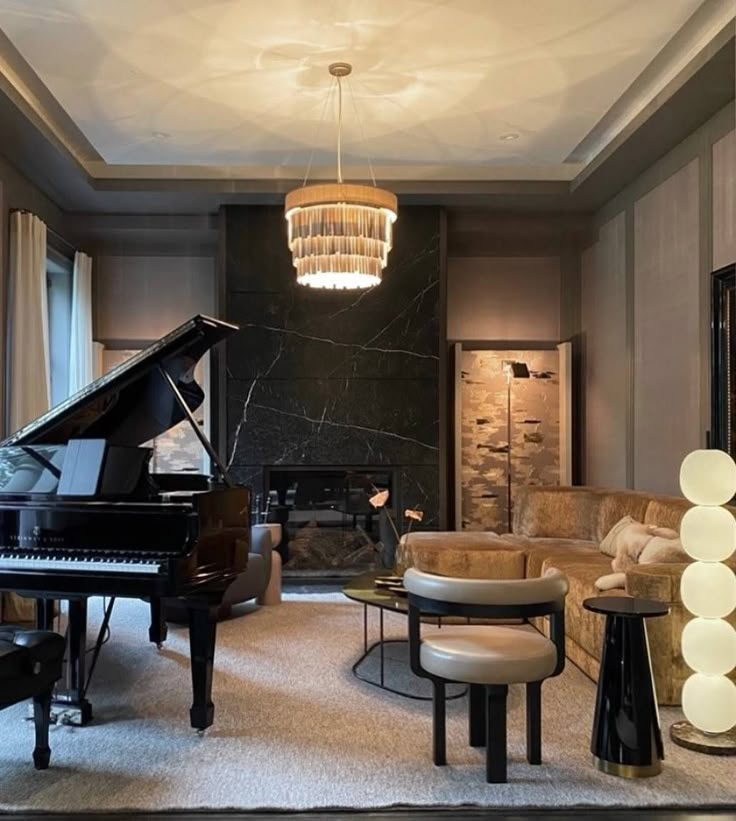
Statement light fixtures become instant focal points that define the piano room’s overall style. Whether selecting a dramatic chandelier, modern pendant, or vintage sconce, lighting choices offer both functional and aesthetic value. Proper illumination is essential for reading sheet music, making adjustable fixtures a practical option. Brass, crystal, or matte black finishes can be matched to the piano’s design for visual cohesion. Layering lighting elements, such as combining overhead fixtures with wall sconces or floor lamps, ensures balanced light coverage throughout the space. Artistic or sculptural lighting pieces double as décor, adding elegance without cluttering the area. Selecting dimmable options allows for adjusting the mood, creating a bright practice environment or a soft, intimate ambiance for evening performances. Thoughtful lighting enhances the piano’s prominence while complementing the room’s design. A well-chosen light fixture not only elevates the decor but also showcases the piano as the centerpiece of a beautifully curated space.
Create a Cozy Reading Nook Adjacent to the Piano

Designing a snug reading nook beside the piano enriches the room’s multifunctionality while maintaining a cohesive flow. A cozy armchair upholstered in rich fabric, paired with a floor lamp and a side table, invites relaxation and quiet moments of reflection. Adding built-in shelves stocked with music books, classic novels, or sheet music enhances the space’s literary charm. Selecting warm tones and plush textiles helps create a soothing atmosphere, encouraging extended stays within the nook. Carefully placed near the piano, the reading area offers easy access to musical scores, making practice sessions more efficient. This integration allows the space to serve as both a creative studio and a retreat for quiet leisure. Thoughtful accents like throw pillows or a small area rug delineate the nook without overwhelming the overall design. A well-designed reading corner not only complements the piano but also fosters a peaceful environment where creativity and relaxation harmoniously coexist.
Use a Folding Screen as a Decorative Backdrop
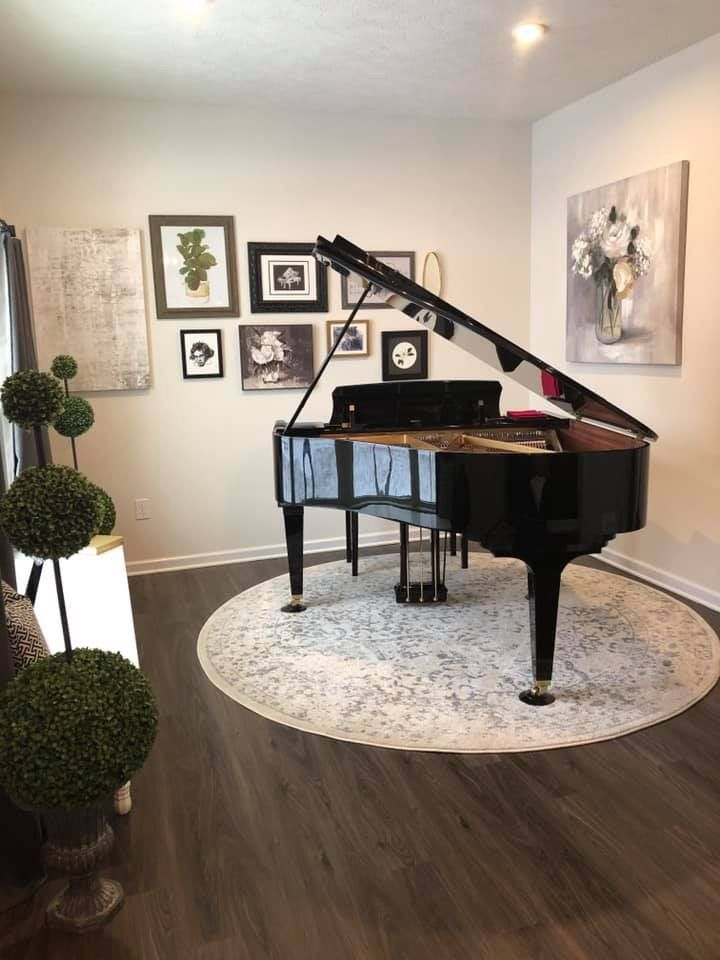
A decorative folding screen placed strategically behind the piano serves as both an artistic feature and a functional design element. These screens, available in various materials like wood, fabric, or metal, help frame the instrument while introducing texture and visual depth. Hand-painted designs, intricate carvings, or even mirrored panels elevate the room’s sophistication and can reflect personal style. Positioning the screen creates a defined backdrop, allowing the piano to stand out without distractions. It also adds flexibility by subtly dividing the space or concealing less appealing views. Screens work especially well in open-concept layouts, offering privacy and a cozy atmosphere without permanent construction. Choosing designs with musical or vintage motifs ties the aesthetic to the piano’s timeless charm. Lightweight and movable, folding screens can be easily repositioned or updated, offering versatility. Their combination of form and function enhances the decor while emphasizing the piano as the star attraction of the room.
Incorporate Built-In Shelving Around the Piano
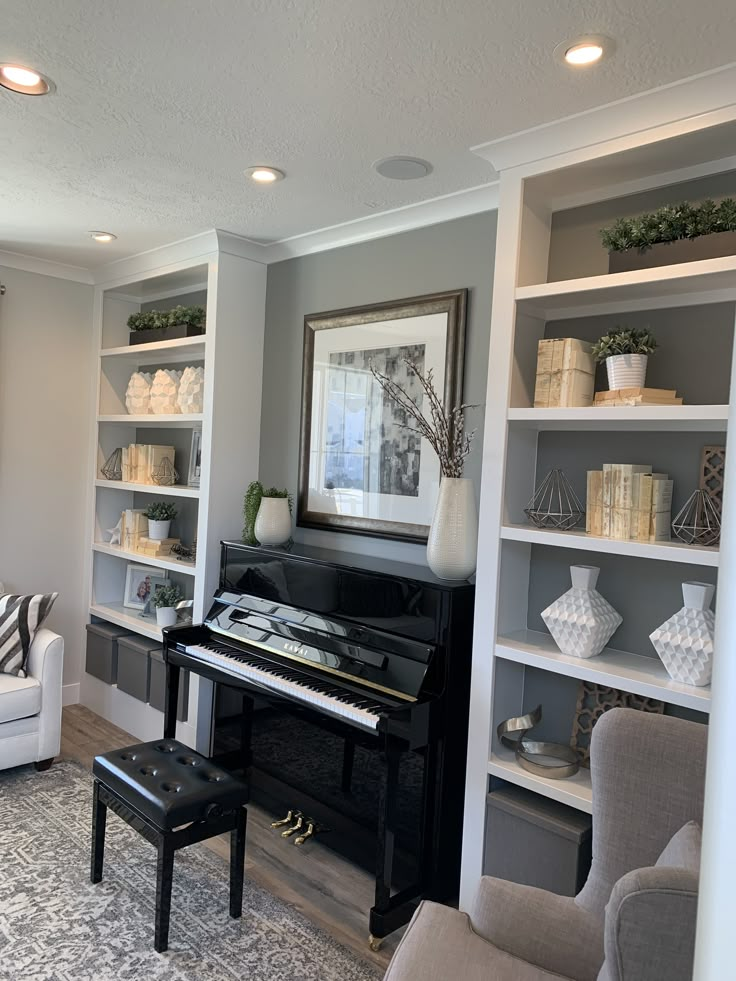
Built-in shelving surrounding the piano creates a seamless blend of functionality and elegance. These custom shelves provide ample space for displaying treasured music books, instruments, or decorative objects, adding character to the room. Tailoring the design to match the piano’s finish ensures visual cohesion while maximizing storage without crowding the area. Floating shelves or cabinetry on either side of the instrument frame it beautifully, drawing focus while keeping essentials within arm’s reach. Consider adding integrated lighting to spotlight collections and enhance the overall atmosphere. The shelves also serve as a sound buffer, subtly improving acoustics by diffusing sound waves. A mix of open shelves and closed cabinetry allows for both display and concealed storage, maintaining a clean, organized look. This thoughtful addition enhances functionality while reinforcing the piano room’s purpose as a creative sanctuary. Built-ins deliver practicality and style, turning the piano area into a curated focal point filled with personal charm.
Add a Pop of Color with an Accent Wall

An accent wall introduces personality and vibrancy to the piano room while defining the space. Opting for bold colors, patterned wallpaper, or textured finishes transforms a plain backdrop into a statement feature that enhances the piano’s presence. A rich jewel-toned wall contrasts beautifully with the piano’s sleek finish, creating depth and drawing attention to the instrument. Alternatively, wallpapers featuring subtle metallics, classic damasks, or music-inspired patterns add artistic flair without overwhelming the room. This design choice serves as a visual anchor, especially in open-plan layouts where defining zones is essential. Complementary decor, such as matching cushions or framed art, ties the accent wall into the overall scheme. Ensuring balance with neutral tones elsewhere prevents the space from feeling overly busy. The accent wall becomes a dynamic backdrop, reinforcing the room’s creative purpose while showcasing the piano as the centerpiece. It’s a simple yet impactful way to personalize and elevate the space.
Utilize Area Rugs to Define the Space
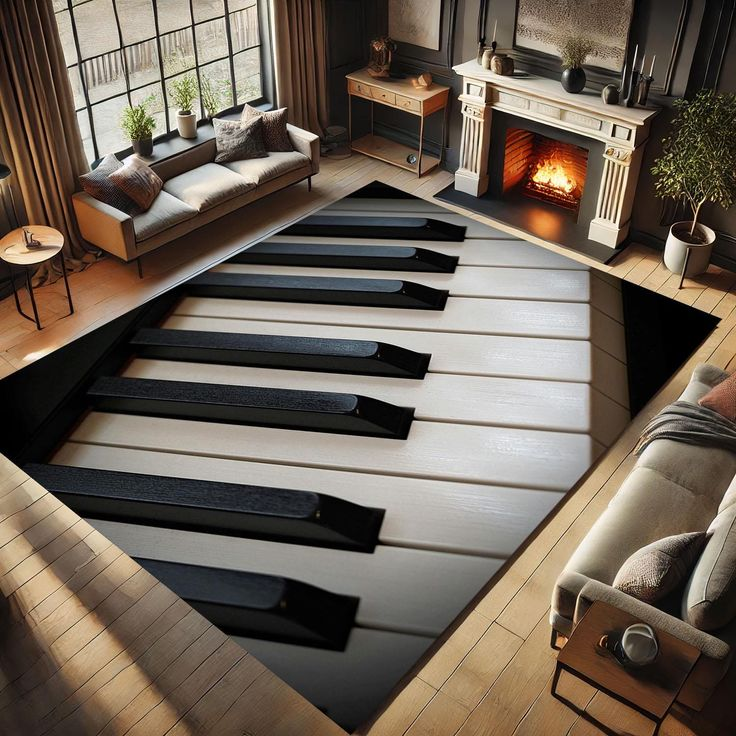
Area rugs offer both functional and aesthetic benefits by clearly defining the piano room’s layout. Placing a high-quality rug beneath the piano anchors the instrument, while softening hard surfaces and enhancing acoustic performance. Patterns, colors, and textures should complement the piano’s finish and the overall room decor, creating a cohesive design. Materials like wool or natural fibers provide durability and sound absorption without muffling the piano’s tone. Layering rugs can also add depth, especially in spacious rooms where visual warmth is needed. A carefully chosen rug prevents scratches on hardwood floors while delineating the music zone within open-concept spaces. Additionally, rugs help reduce echo, improving sound quality during practice sessions or performances. Selecting the right size ensures proper scale—large enough to frame the piano and bench but not overwhelming the room. This thoughtful design element balances style and function, creating an inviting, acoustically enhanced environment perfect for music lovers.
Incorporate Vintage or Antique Accents
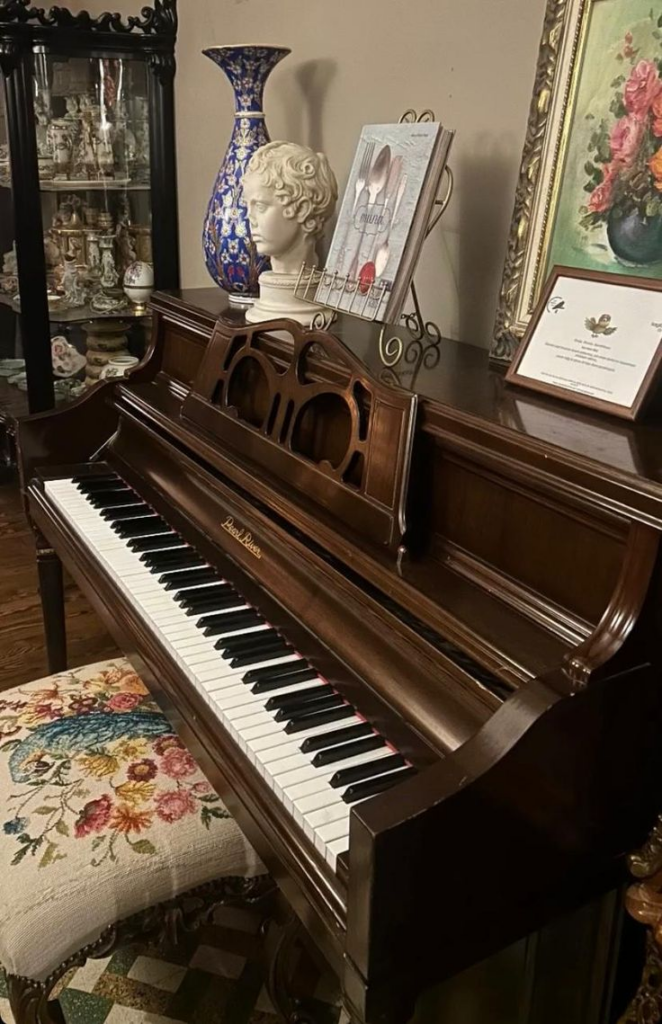
Vintage and antique accents bring timeless charm and character to a piano room, creating an inviting, nostalgic atmosphere. Thoughtfully sourced pieces like ornate candleholders, aged mirrors, or antique side tables add layers of history and personality. Incorporating vintage sheet music or framed historical prints connects the decor directly to the room’s musical purpose. Distressed finishes, weathered wood, or brass hardware evoke a sense of warmth and authenticity that complements both classic and modern pianos. These accents work harmoniously with contemporary elements, creating a curated look that feels intentional and refined. Flea markets, antique shops, or family heirlooms offer endless possibilities for unique, meaningful pieces. Layering vintage finds with modern furniture prevents the space from appearing overly traditional, striking a perfect balance. This blend of old and new enhances the piano’s presence while telling a story of artistry and heritage. Ultimately, vintage decor infuses the space with enduring charm and refined elegance.
Use Floating Shelves for Display

Floating shelves offer a minimalist way to display treasured decor while keeping the piano room uncluttered and refined. Installed above or adjacent to the piano, these shelves provide space for showcasing music books, small sculptures, framed photos, or plants without overwhelming the area. Selecting materials that complement the piano’s finish, such as dark woods or matte metals, ensures visual harmony. Arranging items with varying heights and textures creates dynamic interest while maintaining balance. Floating shelves also allow flexibility—seasonal decor or new finds can be swapped easily to refresh the space. Careful placement prevents interference with acoustics while subtly framing the piano as the focal point. Integrating hidden LED lighting beneath the shelves enhances display pieces and adds ambient glow, perfect for evening music sessions. The clean lines of floating shelves lend a contemporary touch, offering both functionality and aesthetic appeal. This thoughtful addition keeps the space organized, stylish, and musically inspiring.
Create a Dual-Purpose Space with a Home Office

Showcasing artwork above the piano creates a refined focal point that draws attention to the instrument. A gallery wall filled with curated art pieces, family photos, or musical-themed prints adds visual interest while personalizing the space. Opt for matching frames or a mix of finishes to reflect your style, ensuring the arrangement feels cohesive. This approach enhances the room’s character while complementing the piano’s grandeur. Large statement art pieces or symmetrical clusters create balance without overwhelming the area. Keep the spacing even to avoid a cluttered look and let each piece breathe. Incorporating vintage sheet music or framed musical notes ties the theme together beautifully. Selecting art with varying textures and hues adds dimension, while picture lighting subtly highlights the collection. The gallery wall not only elevates the aesthetic appeal but also creates a harmonious backdrop, making the piano a centerpiece within a well-curated, elegant setting.
Implement Acoustic Panels as Decorative Elements
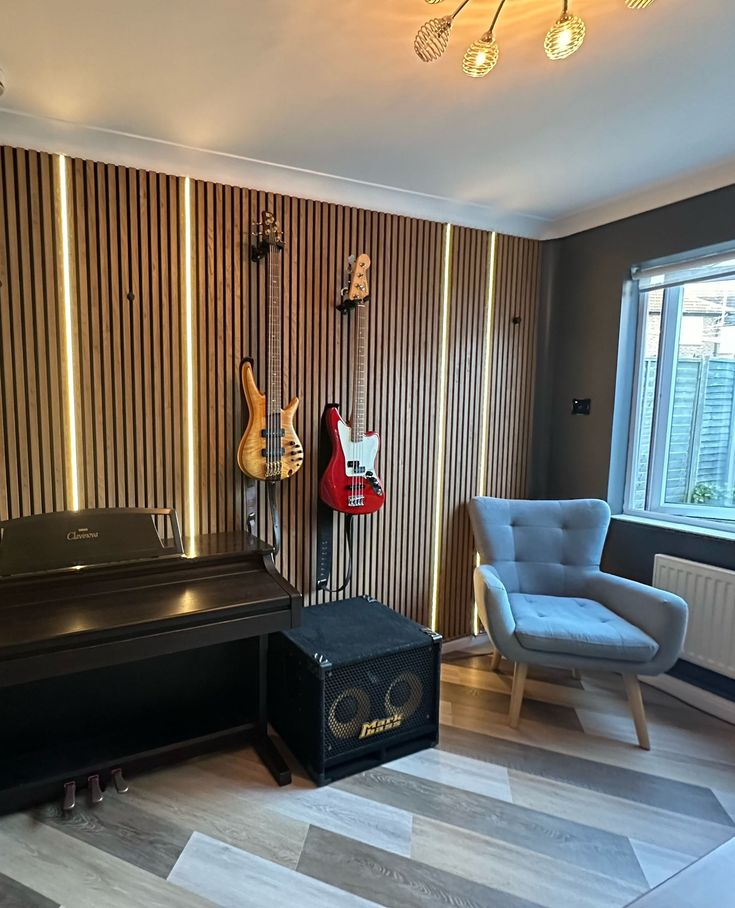
Blending a home office within the piano room maximizes functionality while maintaining an elegant aesthetic. A sleek desk and comfortable chair positioned thoughtfully ensure the workspace feels intentional without detracting from the piano’s prominence. Incorporating complementary finishes and materials allows both zones to coexist harmoniously. Utilizing shared storage solutions, like built-in shelves or cabinets, keeps essentials organized and visually cohesive. Soft task lighting ensures sufficient illumination for work without overpowering the room’s ambiance. Adding personal touches such as framed sheet music or musical motifs bridges the gap between productivity and creativity. This multi-purpose setup suits smaller homes where maximizing space is essential while still offering a dedicated area for music practice. Acoustic considerations, like area rugs or drapery, help manage sound for both activities. The seamless integration of a home office creates a versatile environment, allowing users to transition effortlessly from work tasks to musical exploration within the same refined space.
